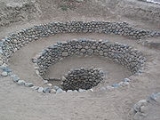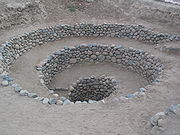
Puquios
Encyclopedia

Aqueduct
An aqueduct is a water supply or navigable channel constructed to convey water. In modern engineering, the term is used for any system of pipes, ditches, canals, tunnels, and other structures used for this purpose....
s near the city of Nazca
Nazca
Nazca is a system of valleys on the southern coast of Peru, and the name of the region's largest existing town in the Nazca Province. It is also the name applied to the Nazca culture that flourished in the area between 300 BC and AD 800...
, Peru
Peru
Peru , officially the Republic of Peru , is a country in western South America. It is bordered on the north by Ecuador and Colombia, on the east by Brazil, on the southeast by Bolivia, on the south by Chile, and on the west by the Pacific Ocean....
. Out of 36 Puquios, most are still functioning and relied upon to bring fresh water into the arid desert. The Puquios have never been fully mapped, nor have any been excavated .
Debate about age
There is conflicting research regarding when the aqueducts were actually built. Many archaeologists contend that they were built by Pre-ColumbianPre-Columbian
The pre-Columbian era incorporates all period subdivisions in the history and prehistory of the Americas before the appearance of significant European influences on the American continents, spanning the time of the original settlement in the Upper Paleolithic period to European colonization during...
Nazca architects around A.D. 540 in response to two prolonged droughts during that time. There is a general lack of historical reference both after and prior to the Spanish Empire
Spanish Empire
The Spanish Empire comprised territories and colonies administered directly by Spain in Europe, in America, Africa, Asia and Oceania. It originated during the Age of Exploration and was therefore one of the first global empires. At the time of Habsburgs, Spain reached the peak of its world power....
. The first historical writing of their existence was in 1605 by Reginaldo de Lizárraga, which some contend may indicate that they were built by the Spanish. There, however, is yet no evidence from Spanish texts that mentions a project to build the Puquios..
In their book "Irrigation and Society in the Peruvian Desert", Katharina Schreiber and Josue Lancho Rojas explore puquios and show evidence that puquios were constructed by a pre-Hispanic civilization.
Relation to Nazca Lines
Another controversy regarding the Puquios, is an assertion made by David JohnsonDavid Johnson
David Johnson may refer to:* C. David Johnson , Canadian actor* David Johnson , American painter* David Johnson , American former college football quarterback...
that the Nazca Lines
Nazca Lines
The Nazca Lines are a series of ancient geoglyphs located in the Nazca Desert in southern Peru. They were designated a UNESCO World Heritage Site in 1994. The high, arid plateau stretches more than between the towns of Nazca and Palpa on the Pampas de Jumana about 400 km south of Lima...
depict maps
MAPS
Maps is the plural of map, a visual representation of an area.As an acronym, MAPS may refer to:* Mail Abuse Prevention System, an organisation that provides anti-spam support...
and pointers to the subterranean
Subterranea (geography)
Subterranea refers to underground structures, both natural and man-made . Some subterranea include:* Bunker* Casemate* Catacombs* Caves** Ice caves* Cave dwellings, Cave house* Cave temple* Cellar* Cenote* Dungeon...
aquifers that feed the Puquios system.

